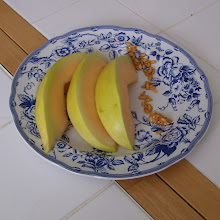Unlike the ciaccona, which runs the gamut of emotions, this fugue hardly has a development, the minor section where everything seems to get complicated. I think that's part of the "problem." Every once in a while, there's a minor phrase, but then it goes back to major again, the music punctuated chords on every downbeat.
I just don't understand how something that seems rather harmless and nice but not meaningful would go on for so long. The ciaccona changes with each repetition of the theme. This is more like a happy dirge.
Overall, this sonata doesn't have much melancholy to it. I just wonder what Bach was thinking when he wrote that fugue. Did he like it? How could he be moved to write something so flat? I've got an idea: blame the king. Bach was a court composer. Maybe the king said, upon hearing the ciaccona, "God, can't we have a little something cheerful for a change?" and Bach decided that if he were going to write something just to please the king, he might as well make it ten minutes long.
On the other hand, the first and third movements, the slow ones, are beautiful to me. The first movement of this same sonata is also a repetition of a theme with chords on the downbeats, but it has much more emotional range than the fugue that follows it.
The unaccompanied Bach was long viewed not as real music but as a set of violin studies. I'd believe it with this fugue, which seems to say little using lots of difficult chords. Each chord, each downbeat, is a pitfall for an amateur violinist seeking passage from beginning to end. I will enjoy struggling to play it.

fun to listen to. having taken heed of your words, i was prepared for the worst, but was pleasantly surprised. not his most lyrical work, or his most adventurous but enjoyable nonetheless. quite elegant throughout.
ReplyDelete